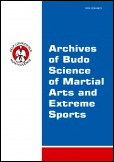2023, Volume 19, Issue 1
Reaction time and special fitness of tennis players aged 10-12 years
Tomasz Waldziński1
1Faculty of Health Sciences, Lomza State University of Applied Science, Lomza, Poland
Author for correspondence: Tomasz Waldziński; Faculty of Health Sciences, Lomza State University of Applied Science, Lomza, Poland; email: twaldzinski@ansl.edu.pl
Full text
Abstract
Background & Study Aim: Reaction time is the time elapsed from the stimulus (nerve impulse) to the initiation of movement. This ability involves performing a deliberate motor action in the shortest possible time, utilizing the entire body or a specific part of it. Excellent speed and short reaction time are among the most essential elements of modern tennis. A lightning-fast start towards the ball, quick decision-making during returns or volleys (especially in doubles matches) can contribute to high performance in tennis. Recent match analyses of the world's top tennis players have shown that speed is the motor skill that distinguishes the exceptional among the best players. The aim of the study was to knowledge of the relationship between reaction time and special fitness of tennis players aged 10-12 years old.
Material & Methods: The study involved 45 tennis players training in clubs in the Podlaskie Voivodeship, Poland. The participants were divided into age categories, and the tennis players varied in their level of sport advancement. Two tests were used to assess reaction time: Blink.Pro Infinity (reaction time test); International Tennis Number (special fitness of tennis players test).
Results: Positive average and high correlation coefficients between reaction time test (Blink) and special fitness of tennis players test (ITN) scores increased with the age of the tennis players tested: 10-year-olds r = 0.358 (average correlation) and positive correlations 11-year-olds r = 0.521, p<0.05 and 12-year-olds r = 0.599, p<0.02.
Conclusions: The results of the study provide evidence that the training of juvenile tennis players influences not only the increase of their special fitness, but also the speed (effectiveness) of their motor response to stimuli simulated in laboratory conditions. The increasing interdependence of the indices of both variables (special fitness and reaction time to external stimuli) with age indicates that stimulating the natural process of biological growth of the organism at this stage of ontogenesis with specific tennis exercises has a positive effect on this component of coordination ability (motor reaction time), which is related to human motor safety in the general sense (health and survival).
Key words: Blink.Pro Infinity, innovative agonology, International Tennis Number, motor safety, motor skill





